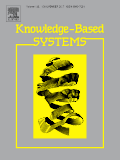Editors, Aims & Scope
On interval type-2 rough fuzzy sets
Hybrid method for the analysis of time series gene expression data
Communicative commitments: Model checking and complexity analysis
Control of discrete chaotic systems based on echo state network modeling with an adaptive noise canceler
Self-adaptive semantic web service matching method
Computationally efficient induction of classification rules with the PMCRI and J-PMCRI frameworks
Policy-enhanced ANFIS model to counter SOAP-related attacks
Evidential cognitive maps
Online reputation management for improving marketing by using a hybrid MCDM model
Bipolar fuzzy rough set model on two different universes and its application
Credit risk assessment and decision making by a fusion approach
Distributed customer behavior prediction using multiplex data: A collaborative MK-SVM approach
A pattern-based knowledge editing system for building clinical Decision Support Systems
The operations on intuitionistic fuzzy values in the framework of Dempster–Shafer theory
Ontology-driven relational query formulation using the semantic and assertional capabilities of OWL-DL
Semantically-grounded construction of centroids for datasets with textual attributes
A new relational Tri-training system with adaptive data editing for inductive logic programming
A tree structure for event-based sequence mining
Group consensus based on evidential reasoning approach using interval-valued belief structures
A Bayesian stochastic search method for discovering Markov boundaries
BiMine+: An efficient algorithm for discovering relevant biclusters of DNA microarray data
Nonparametric bivariate copula estimation based on shape-restricted support vector regression
Hybridization of evolutionary Levenberg–Marquardt neural networks and data pre-processing for stock market prediction
No-arbitrage determinant theorems on mean-reverting stock model in uncertain market
Clustering-oriented privacy-preserving data publishing
Directed graph-based multi-agent coalitional decision making
Identifying the semantic orientation of terms using S-HAL for sentiment analysis
Analysis of the problem description in the Algorithm for Inventive Problem Solving using Petri nets
Semi-supervised fuzzy clustering with metric learning and entropy regularization
Statistical cross-language Web content quality assessment
Mining event logs to support workflow resource allocation
Executing SQL queries over encrypted character strings in the Database-As-Service model
S-Trans: Semantic transformation of XML healthcare data into OWL ontology
A new optimal consensus method with minimum cost in fuzzy group decision
Selective Subsequence Time Series clustering
Time efficient reconciliation of mappings in dynamic web ontologies

